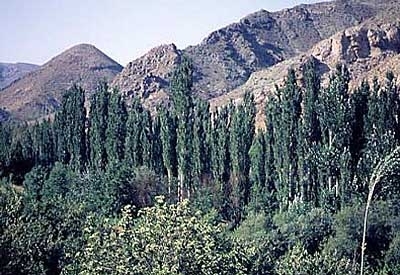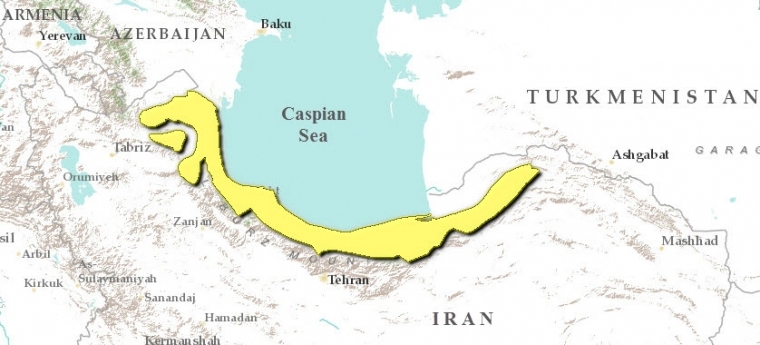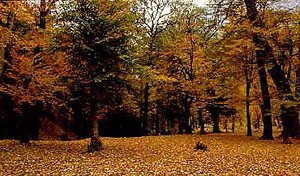Caspian Hyrcanian mixed forests
The mixed forests of the southern coast of the Caspian Sea represent a key habitat for many different species of avifauna. Migratory species visit the area on stopovers between Russia and Africa. Other species, such as little bustard (Otis tetrax), peregrine falcon (Falco peregrinus), and squacco heron (Ardeola ralloides) use it as breeding grounds. Hyrcanian forests are relicts from the Tertiary. Consequently, they are rich in relic and endemic plant species. Several protected areas such as the Gizil-Agach strict nature reserve, the Zuvand conservation area and Girkan strict nature reserve have been set up to protect threatened flora and fauna. Habitat destruction (Land-use and land-cover change) for agriculture use is the main threat to the ecoregion.
Location and General Description
This ecoregion covers the Lenkoran lowland and Talysh mountains of southeast Azerbaijan and adjoining territories of northwest Iran along the Caspian shoreline. Part of the Iranian-Turanian biogeographic subregion, this area represents the Hyrcanian refuge of Tertiary flora representatives.
The Lenkoran region occupies lowland areas on the southwestern coast of the Caspian Sea. A peculiar, semi-subtropical climate with prolonged summer droughts and heavy precipitation in other seasons of the year is typical for this region. The annual average temperature is +140 degrees Celsius, and precipitation ranges from 900-1600 millimeters (mm) increasing from south to north.
The territory of the Talysh region is formed from Paleogenic volcanic and volcanogenic-sedimentary deposits. Sulfate-carbonate and hydrocarbon mineral thermal springs are common in this region. Hyrcanian forests are relicts from the Tertiary. Consequently, they are rich in relic and endemic species.
Lowland has been covered by alder (Alnus barbata) forests: now this areas are almost totally under agricultural and urban lands. Characteristic vegetation on the Talysh mountain consists of humid oak forests rich in relic and endemic species. For instance, Quercus castaneifolia with Parrotia persica, Zelkova carpinifolia, Albizzia julibrissin, Diospiros lotus, etc. with shrubs/semi-shrubs Ilex hyrcana, Ruscus hyrcanus, Danaë racemosa, and lianas - Smilax excelsa, Hedera pastuchowii, etc. are found in the lower mountain zone. These are replaced by oriental beech forests (Fagus orientalis) in the middle mountains. Upper mountain-subalpine elevations are occupied by steppes and xeric dwarf semi-shrubs and oriental oak (Quercus macranthera) which is also characteristic for the Elburz Mountains. Alpine meadows occur at the highest elevations.
Biodiversity Features
The distinctive forests of this region include many range-restricted species as Quercus castaneifolia, Zelkova carpinifolia, Parrotia persica, Albizzia julibrissin, Buxus hyrcana, Danaë racemosa, etc. The region is outstanding for its rich agrobiodiversity with numerous endemic cultivated taxa.
The Caspian tiger (Panthera tigris virgata) is now extinct. Other mammals which still inhabit the area are critically endangered leopard (Panthera pardus ciscaucasica), lynx (Lynx lynx), brown bear (Ursus arctos), wild boar (Sus scrofa), wolf (Canis lupus), jackal (C. aureus), jungle cat (Felis chaus), badger (Meles meles), and otter (Lutra lutra).
Several hundred bird species are found here. Some examples are the graylag goose (Anser anser), white-fronted goose (Anser albifrons), Little bustard (Otis tetrax), glossy ibis (Plegadis falcinellus), Eurasian spoonbill (Platalea leucorodia), night heron (Nycticorax nycticorax), red-breasted goose (Branta ruficollis), peregrine falcon (Falco peregrinus), Pelecanidae, buff-backed heron (Bubulcus ibis = Ardeola ibis), squacco heron (Ardeola ralloides), greater flamingo (Phoenicopterus roseus), white-headed duck (Oxyura leucocephala), and Caspian snowcock (Tetraogallus caspius).
Current Status
The natural landscape has been considerably altered by intensive agriculture development. Tea, vegetables, subtropical fruit, and vine production are main agricultural activities. The most important protected protected areas areas in Azarbaijan part of this ecoregion are: the Gizil-Agach strict nature reserve (88,400 hectares (ha) wetlands and marine area, designated to protect waterfowl), the Zuvand conservation area (15,000 ha, mountain meadows and forests, designated to protect game birds, bear, leopard, and rare reptiles), and the Girkan strict nature reserve (3,000 ha, humid thermophilous Hyrcanian forests, designated to protect the unique plant communities rich in relic and endemic species).
Types and Severity of Threats
The main threats to this ecoregion are agriculture, unsustainable forestry practices, and poaching.
Justification of Ecoregion Delineation
This ecoregion includes the south Caspian coastal plain and northern slopes of the Elburz mountains at lower altitudes. Ecoregion boundaries were defined using Hyrcanian and sub-Hyrcanian mesic forests from Zohary’s geobotanical map of the Middle East. There is a strong correspondence to the Hyrcanian forests in Davis et al.
Additional information on this ecoregion
- For a shorter summary of this entry, see the WWF WildWorld profile of this ecoregion.
- To see the species that live in this ecoregion, including images and threat levels, see the WWF Wildfinder description of this ecoregion.
- World Wildlife Fund Homepage
Further Reading
- Azerbaijan. 1997. State of the Environment Report. State Committee for the Environment, and UNDP, Baku.
- Davis, S.D., V.H. Heywood, and A.C. Hamilton, editors. 1994. Centres of plant diversity: A guide and strategy for their conservation. Volume 1. WWF and IUCN, Cambridge, UK. Europe, Africa, SW Asia, Middle East. ISBN: 2831701988
- Gasanov, Kh.N. 1990. Girkan Strict Nature Resrve (Zapovednik). Zapovedniks of the Caucasus. Publishing House "Misl", Moscow.
- Millington S., and R. Gokhelashvili. 2000. Biodiversity Assessment for Azerbaijan. Report to USAID. Chemonics International Inc, Washington, DC.
| Disclaimer: This article is taken wholly from, or contains information that was originally published by, the World Wildlife Fund. Topic editors and authors for the Encyclopedia of Earth may have edited its content or added new information. The use of information from the World Wildlife Fund should not be construed as support for or endorsement by that organization for any new information added by EoE personnel, or for any editing of the original content. |


